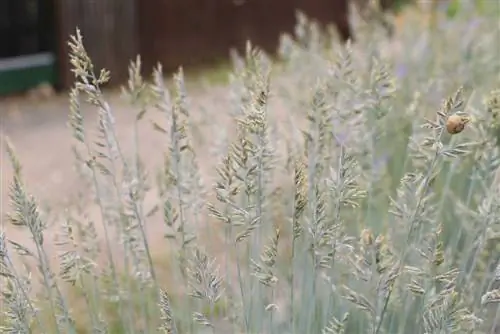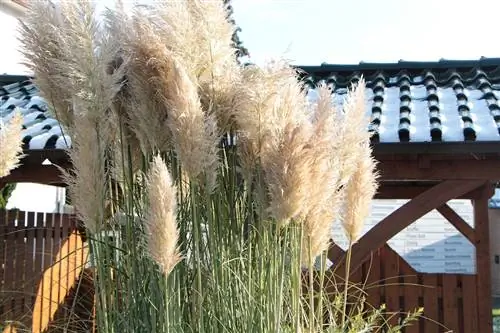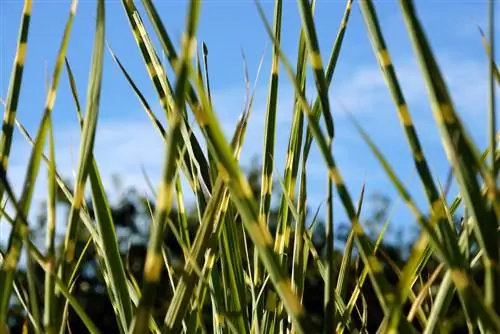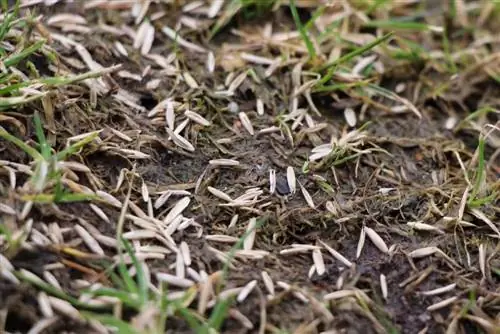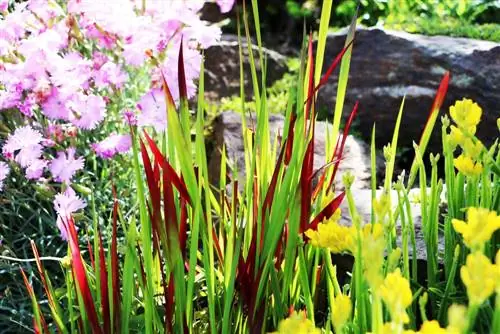- Author admin [email protected].
- Public 2023-12-17 03:39.
- Last modified 2025-01-24 12:45.
Bear skin grass is particularly suitable for rock and heather gardens. It is also increasingly being planted on green roofs, as the grass quickly forms a dense, green cushion. It is a robust, undemanding plant that can survive winters in cold regions.
General information about bearskin fescue
The bearskin fescue is also known as bearskin grass and belongs to the sweet grass family. The botanical name is Festuca gautieri. This Festuca group includes several fescue grasses, including the well-known blue fescue. What they all have in common is that the stalks of the grass do not grow higher than 20-30 cm. In bearskin fescue, the green stalks are needle-like, fine and prickly. The grass forms clumps which, with several plants, soon grow together to form a dense, ground-covering cushion. It is evergreen, perennial, undemanding and hardy. From June onwards, the small, tightly upright flower panicles push out between the blades of grass, which are up to 30 cm long and bloom from July to August in a yellow-green to brown color.
The bearskin grass has a beautiful effect in rock and heather gardens, gravel beds, joints of tread slabs, but also as pot and trough underplanting, as edge planting in perennial beds and on green roofs. Group plantings of bearskin fescue can spread over entire areas and are particularly attractive. By the way: Snails don't like this grass at all.
Different types of bearskin fescue
- Festuca gautieri, green stalks up to 30 cm, prefers dry, barren soils
- Festuca scoparia, similar in appearance to gautieri, but prefers moist soils and can be planted along pond edges
- Festuca gautieri, variety 'Pic Carlit', is a small bearskin fescue that only grows to 10 cm high
Location and soil requirements of bearskin grass
The bearskin fescue loves a sunny to slightly partially shaded spot. Its original home is the Pyrenees, where it grows on rocky slopes. Accordingly, it also needs permeable, nutrient-poor and relatively dry soil in the garden. Bearskin grass thrives very well in gravel beds together with other grasses. On such soils the grass can live up to fifteen years. If, on the other hand, it receives too many nutrients, the bearskin grass becomes bald and ages from the inside out. For this reason, it only receives a small amount of fertilizer in spring. It should also not be watered excessively. However, additional watering is required during longer dry periods.
Planting Bearskin Fescue
The bearskin fescue should not be planted too densely at first, 6-8 plants per square meter depending on size. It is best to plant grasses in spring; the planting hole should not be too large. The nest base must be above ground level. Press the soil around the inserted grass well and water it. When planting, you can add some compost or a little fertilizer; this will then be sufficient throughout the year. For this reason, underplanting potted plants is not necessarily recommended, as they need plenty of fertilizer throughout the summer. The grass, on the other hand, then develops soft stalks, falls apart and becomes bare.
Propagation
For grasses, propagation is easy: either by sowing or by dividing the clump. To avoid uncontrolled sowing, the flower spikes must be cut off before maturity. If you let them dry, the seeds can be taken from the ripe panicles for re-sowing. To germinate, a pot is filled with potting soil onto which the seeds are scattered. Press them down lightly, spray them with moisture and put a plastic bag over the pot. With consistent moisture and warmth, the seeds will soon germinate and grow quickly. The new bearskin fescue plants can then be planted in the fall, but they need light winter protection with leaves or brushwood. Another option is to divide larger plants. To do this, they are dug up and divided with a spade or a sharp knife. Dried or bare areas are cut away. Then you put the grass plants back in. This type of propagation is best done in autumn.
Overwintering and cutting bearskin grass
The bearskin fescue is a hardy plant that does not need frost protection. The evergreen grass is particularly attractive in winter when there is frost. Heavy snow sometimes compresses the grasses, which then have brown spots in the middle in spring. In this case, division is advisable. The flower spikes are cut off at the latest after they have faded and ripened. If they remain standing for too long, they will sow themselves and sometimes spread very widely. The grass itself is generally only cut off in spring, otherwise moisture will penetrate the remaining stalks and the roots can rot. Higher grasses are tied together over the winter, but this is not necessary for bearskin grass.
What you should know about bearskin grass in brief
- Suitability: ideal plant for rock and heather gardens, green roofs or large-scale plantings
- Partner: fits well in small tuffs to loosen up herbaceous beds
- Diseases and pests: unknown, snails also avoid the grass
- Species/Family: Perennial. Belongs to the sweet grass family (Poaceae)
- Care effort: low, undemanding, frugal and requires little care
- Flowering period: June to July
- Foliage: wintergreen, grass-like lush green solid leaves
- Growth: Ground cover, forms dense, cushion-like, well-branched clumps over time
- Height: 15 to 30 cm, with inflorescences 45 cm
- Planting time: any time as long as the ground is not frozen
- Pruning: to just above the ground in the spring before new growth, otherwise withered stems should be cut back completely in August
- Topiary pruning: for compact growth, cut out the flower stalks immediately after they appear
- Propagation: division in autumn
- Care: Fertilizer applications (see fertilization below) or additional irrigation are not necessary.
- Watering: only if it is protected from the rain
- Wintering: absolutely hardy
Older plants tend to fall apart. To prevent this, cut back and divide in the fall (called rejuvenation). Bearskin grass can also be cultivated well in a container. You should give yourself an additional supply of nutrients with this frugal grass, as it naturally grows on poor soils. You're not doing it any favors because it then grows extremely quickly and loses its compact shape. It also becomes vulnerable to pests, disease and frost. In addition, it usually loses its beautiful, intense green color.

